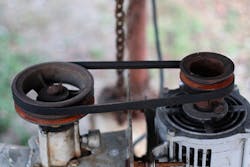Tightening Our Belts, Part 1
In many maintenance departments, drive belts don’t get the proper attention. Because the belt is motor-driven, some managers think it’s an electrical item. Because it drives a pulley and it doesn’t have wires attached, some managers think it’s a mechanical item. One consequence of this is there’s no formal training on drive belt inspection, adjustment, or replacement.
Typically, there’s not a specification on the belt tightness or an instrument for measuring it. Loose belts waste energy and fail prematurely; tight belts waste energy and cause motor bearings to fail prematurely. One tech goes out to a squeaky belt, realizes it’s too loose, and adjusts it too tightly to fix the problem.
Then there are belt dressings. Can anyone at your plant explain why you use the particular dressing you use (if you use one) on a given belt and how much of it to apply when performing the PM? Does your PM call for checking the sheave or sprocket alignment? If so, what is the correct procedure? How do you know that?
We’ll start addressing these issues in the next issue.
